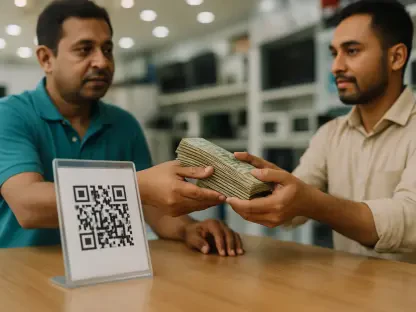Blockchain technology has grown beyond its origins in cryptocurrency, increasingly being adopted across various sectors for its potential to revolutionize security and transactional integrity. Notably, large financial institutions and startups alike are leveraging blockchain to mitigate fraud and enhance financial security. This technological innovation promises to offer unparalleled transparency and efficiency in combating issues that have long plagued traditional financial systems, such as data inaccuracies and fraud. As blockchain continues to mature, its applications in fraud prevention and financial security are becoming more pronounced, signifying a fundamental shift in how financial transactions are conducted and secured.
The Evolution of Blockchain in Financial Services
In recent years, the financial industry has witnessed a paradigm shift, with blockchain emerging as a transformative element. JPMorgan, a leader in financial services, has been at the forefront of this movement with its innovative blockchain-based solution, Confirm. By integrating Confirm into their operations, Trustpair, a firm specializing in fraud prevention, aims to enhance the verification of vendor bank accounts, reducing payment fraud and delays significantly. The adoption of Confirm, which runs on JPMorgan’s private blockchain, Liink, underscores how blockchain can ensure higher data accuracy. This initiative demonstrates how the technology addresses inefficiencies in conventional verification processes and enhances overall transaction security.
JPMorgan’s exploration and adoption of blockchain technologies represent a broader industry trend where conventional financial powerhouses are embracing digital innovations to streamline and secure their operations. The company’s Onyx division, which supervises blockchain initiatives like Liink, Coin Systems, Blockchain Launch, and Onyx Digital Assets, indicates a comprehensive commitment to blockchain. This transition not only signifies technological progress but also reflects the financial sector’s tacit acknowledgment of blockchain’s superior ability to deliver secure, efficient, and transparent transactions on a scale that traditional systems have struggled to match.
Institutional Commitment to Blockchain Technology
JPMorgan’s dedication to blockchain extends beyond just Confirm. With the launch of JPM Coin for institutional transactions, the financial giant made significant strides into the digital currency realm. The Onyx division now oversees diverse blockchain ventures, including Liink, Coin Systems, Blockchain Launch, and Onyx Digital Assets. These developments indicate JPMorgan’s comprehensive commitment to leveraging blockchain across various financial operations, heralding a new era of digital finance. The integration of blockchain in these initiatives reflects a strategic shift where traditional financial institutions increasingly embrace digital transformations. This transition represents not only a technological advancement but a broader acceptance of blockchain’s potential to streamline and secure financial services.
The commitment of institutions like JPMorgan to blockchain technology underscores a key trend: the institutionalization of blockchain is not merely speculative but an operational reality. The deployment of projects such as Onyx Digital Assets signifies that blockchain’s utility extends beyond cryptocurrencies into core financial activities, paving the way for tokenization of assets, decentralized financial instruments, and much more. As other major corporations and financial entities follow suit, it becomes evident that blockchain is reshaping the finance industry’s landscape, providing more robust solutions for verification, transaction security, and operational efficiency. This movement encourages more institutions to explore blockchain, fostering systemic technological evolution that transcends traditional financial practices.
Legislative and Regulatory Landscape
The regulatory environment surrounding blockchain and cryptocurrencies is evolving rapidly. In the United States, for example, 49% of voters recognize the significance of digital currencies, hinting at a growing acknowledgment of their importance in the political sphere. This sentiment is mirrored by legislative actions such as Ohio’s bill allowing crypto payments for state taxes, highlighting a progressive approach to blockchain’s integration into the mainstream financial system. However, the regulatory stance remains mixed, as other jurisdictions impose stringent measures on cryptocurrency activities, reflecting ongoing concerns about security and compliance. This duality poses challenges and opportunities for the widespread adoption of blockchain, necessitating a balanced approach to regulation that fosters innovation while ensuring protection.
Legislative efforts towards the regulation of blockchain and cryptocurrencies play a crucial role in the technology’s broader adoption. As governments and regulatory bodies navigate this new terrain, the mixed stance on digital currencies shows the complexity and novelty of these financial instruments. While progressive states and regions may embrace blockchain for its transparency and efficiency, others remain cautious, emphasizing robust security standards and compliance mechanisms to mitigate potential risks. These regulatory dynamics directly impact blockchain’s implementation in financial fraud prevention, pushing companies to adopt stringent security protocols while leveraging the technology’s inherent benefits. As the regulatory landscape continues to evolve, it will shape the future of how blockchain is utilized across global financial systems.
Market Innovations and Financial Products
The cryptocurrency market continues to evolve with the introduction of new financial instruments. The registration of an XRP ETF trust by Bitwise exemplifies the market’s growing sophistication and the increasing acceptance of crypto-based financial products. This trend signifies a crucial step towards mainstream financial markets embracing cryptocurrency assets, paving the way for broader investor participation. Yet, the market remains volatile, as evidenced by delays in Bitcoin ETF inflows, reflecting regulatory hurdles and fluctuating investor sentiment. Despite these challenges, the continued development of exchange-traded funds (ETFs) and other financial instruments points to an enduring interest and belief in the long-term potential of digital assets.
In response to investor demand and market dynamics, financial products like the XRP ETF by Bitwise represent an effort to integrate cryptocurrencies more closely with traditional financial markets. Exchange-traded funds (ETFs) offer a familiar investment vehicle, providing a conduit for conventional investors to partake in the cryptocurrency market without directly managing digital assets. This development signals a blending of old and new financial paradigms, demonstrating how blockchain technology and digital currencies are gradually gaining legitimacy and acceptance within mainstream finance. However, the market’s inherent volatility and regulatory ambiguities remain critical factors that influence investor confidence and the pace of widespread adoption within mainstream financial ecosystems.
Technological Progress and Ecosystem Development
Blockchain’s technological advancements are pivotal to its application and integration across various sectors. Ethereum continues to maintain its leading position with innovations like EigenLayer, designed to expand staking activities. This demonstrates Etherum’s commitment to enhancing its platform’s flexibility and functionality, solidifying its role as a cornerstone of blockchain technology. Similarly, other blockchain networks such as Solana and Polkadot are witnessing significant investment and transaction growth. These developments reflect the increasing interest and confidence in Layer 1 and Layer 2 solutions aimed at improving scalability, speed, and security, essential for the broader adoption of blockchain technology.
Technological progress in the blockchain ecosystem underscores the sector’s dynamic and evolving nature. Platforms like Ethereum, Solana, and Polkadot are crucial in driving innovations that transcend basic cryptocurrency transactions. Their ability to offer scalable, fast, and secure solutions is foundational for broader applications—ranging from decentralized financial services (DeFi) to supply chain management and beyond. Increased investments in these technologies highlight a growing recognition of blockchain’s potential to solve complex real-world problems efficiently. As these platforms continue to grow and innovate, they will undoubtedly propel the entire blockchain ecosystem forward, creating a more robust and versatile technological infrastructure capable of supporting diverse applications across multiple industries.
Security Challenges and Fraud Prevention Efforts
Despite blockchain’s potential to enhance security, the issue of fraud remains prevalent. Reports from CertiK highlight a rapid increase in losses due to crypto-related hacks and scams, stressing the need for enhanced security measures. These incidents underscore the importance of maintaining robust cybersecurity protocols to protect stakeholders in the digital finance ecosystem. Trustpair’s adoption of JPMorgan’s Confirm solution illustrates a proactive approach to tackling these security challenges. By leveraging blockchain for verification processes, companies can significantly mitigate risks and enhance transactional integrity, fostering greater trust in digital financial systems.
The persistent security threats in the blockchain realm emphasize the necessity for continuous advancements in cybersecurity. Blockchain’s promise of immutable and transparent transactions must be complemented by robust defense mechanisms against sophisticated cyber threats. Trustpair’s utilization of JPMorgan’s Confirm solution signifies the practical application of blockchain in fraud prevention, showcasing a model where technology serves as a bulwark against fraud. Such examples illustrate the potential for blockchain to fundamentally alter security strategies in financial operations, offering a safer and more reliable framework for transactions. As companies innovate and improve security measures, the credibility and resilience of blockchain systems will play an increasingly vital role in fostering trust and stability in the financial sector.
Corporate Adoption and Asset Tokenization
Blockchain technology has expanded significantly beyond its initial use in cryptocurrency. It is increasingly being integrated into various industries due to its ability to revolutionize security and ensure transactional integrity. Prominent financial institutions and startups are both utilizing blockchain to reduce fraud and bolster financial security. This pioneering technology promises unmatched transparency and efficiency, addressing long-standing issues in traditional financial systems, such as data inaccuracies and fraud. Blockchain’s role in fraud prevention and financial security is becoming more prominent as the technology matures. This indicates a major shift in how financial transactions are handled and safeguarded.
Moreover, blockchain technology is not limited to the financial sector; its adoption is spreading to other areas like supply chain management, healthcare, and even voting systems. In supply chain management, blockchain can trace the origin of products, ensuring authenticity and reducing counterfeit goods. In healthcare, it offers secure and immutable medical records, enhancing patient privacy and data accuracy. In voting systems, blockchain can provide a tamper-proof method of casting and counting votes, thereby increasing trust in electoral processes. As blockchain continues to evolve, its applications are set to transform various sectors, providing secure, transparent, and efficient solutions to problems that have persisted for years.









